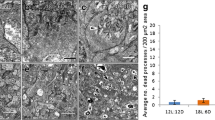Abstract
The implication of dopamine in the modulation of the standing potential of the eye was tested in the chicken by an indirect electrooculogram (EOG) method. After a single rapid systemic injection of dopamine, a transient dose-dependent increase in the EOG voltage was observed. EOG recordings during light and dark adaptation were performed after retinal dopamine depletion was induced by intraocular injections of the neurotoxin 6-hydroxydopamine (6-OHDA). The eyes were injected on two successive days with a mixture of 6-OHDA (50 μg), pargyline (a monoamine oxidase inhibitor), and ascorbate added as an antioxidant. Following this treatment EOG recordings were performed 1, 4, and 8 days after the second injection. The electrophysiological changes appeared most spectacular on the fourth day: an important increase in the EOG basal values as well as of the amplitude of the light peak and of the dark trough were observed. Substantial reduction in retinal concentration of dopamine was found in treated retinas. These unexpected electrophysiological data offer additional evidence for the involvement of a catecholamine in the generation of the light peak and the dark trough of the EOG.
Similar content being viewed by others
References
Ehinger B. Functional role for dopamine in the retina. Progr Retinal Res 1983; 2: 213–32.
Nguyen-Legros J, Versaux-Botteri C, Vigny A, Roux N. Tyrosine hydroxylase immunohistochemistry fails to demonstrate dopaminergic interplexiform cells in the turtle retina. Brain Res 1985; 339: 323–28.
Dawis SM, Niemeyer G. Dopamine influences the light peak in the perfused mammalian eye. Invest Ophthalmol Vis Sci 1986; 27: 330–35.
Marmor MF, Lurie M. Light-induced electrical responses of retinal pigment epithelium. In Zinn KM, Marmor MF, eds. The Retinal Pigment Epithelium. Cambridge, Mass.; Harvard University Press 1979; 226–44.
Noell WK. The visual cell: electrical and metabolic manifestations of its life processes. Am J Ophthalmol 1959; 48: 347–70.
Valeton M, van Norren D. Intraretinal recordings of slow electrical responses to steady illumination in monkey: isolation of receptor responses and the origin of the light peak. Vision Res 1982; 22: 393–99.
Griff ER, Steinberg RH. Origin of the light peak: in vitro study on Gekko gekko. J Physiol (Lond) 1982; 331: 637–52.
Linsenmeier RA, Steinberg RH. Origin and sensitivity of the light peak in the intact cat eye. J Physiol (Lond) 1982; 331: 653–73.
Wioland N, Rudolf G, Bonaventure N. Light- and dark-induced variations of the c-wave voltage in the chicken eye after treatment with sodium aspartate. in preparation.
Kikawada N. Variations in the corneo-retinal standing potential of the vertebrate eye during light and dark adaptation. Jpn J Physiol 1968; 18: 687–702.
Sachs C, Jonsson G. Mechanisms of action of 6-hydroxydopamine. Biochem Pharmacol 1975; 24: 1–8.
Dowling JE, Ehinger B. Synaptic organization of the dopaminergic neurons in the rabbit retina. J Comp Neurol 1978; 180: 203–20.
Olivier P, Jolicoeur FB, Lafond G, Rumheller A, Brunette JR. Effects of retinal dopamine depletion on the rabbit electroretinogram. Doc Ophthalmol 1987; 66: 359–71.
Citron MC, Erinoff L, Richman DW, Brecha NC. Modification of electroretinograms in dopamine-depleted retinas. Brain Res 1985; 345: 186–91.
Wioland N, Bonaventure N. Photopic c-wave in the chicken ERG: sensitivity to sodium azide, epinephrine, sodium iodate, barbiturates and other general anesthetics. Doc Ophthalmol 1985; 60: 407–12.
Rudolf G, Wioland N, Bonaventure N. Participation des couches internes de la rétine à la genèse du “light peak” de l'électrooculogramme chez le Poulet. C R Acad Sci 1987; 305: 427–32.
Linsenmeier RA, Steinberg RH. Mechanisms of azide-induced increases in the c-wave and the standing potential of the intact cat eye. Vision Res 1987; 27: 1–8.
Wioland N, Rudolf G, Bonaventure N. Iodate poisoning of the retina. A highly speciesdependent process. Electrophysiological evidences. Clin Vis Sci 1988; 3: 19–27.
Iuvone PM, Galli CL, Garisson-Gund CK, Neff NH. Light stimulates tyrosine hydroxylase activity and dopamine synthesis in retinal amacrine neurons. Science 1987; 202: 901–902.
Hu KG, Marmor MF. Correlation between the rabbit electroretinogram and standing potential. Invest Ophthalmol Vis Sci 1981; 20 (Suppl): 238.
Gallemore RP, Griff ER, Steinberg RH. Evidence in support of a photoreceptoral origin for the “light peak substance”. Invest Ophthalmol Vis Sci 1988; 29: 566–71.
Bruinink A, Dawis S, Niemeyer G, Lichtensteiger W. Catecholaminergic binding sites in cat retina, pigment epithelium and choroid. Exp Eye Res 1986; 43: 147–51.
Misha RK, Marshall AM, Varmuza SL. Supersensitivity in rat caudate nucleus: effects of 6-hydroxydopamine on the time course of dopamine receptors and cyclic AMP changes. Brain Res 1980; 200: 47–57.
Qu ZX, Neff NH, Hadjiconstantinou M. MPP+ depletes retinal dopamine and induces D1 receptor supersensitivity. Eur J Pharm 1988; 148: 453–57.
Author information
Authors and Affiliations
Rights and permissions
About this article
Cite this article
Rudolf, G., Wioland, N., Kempf, E. et al. Electrooculographic study in the chicken after treatment with neurotoxin 6-hydroxydopamine. Doc Ophthalmol 72, 83–91 (1989). https://doi.org/10.1007/BF00155217
Accepted:
Issue Date:
DOI: https://doi.org/10.1007/BF00155217




